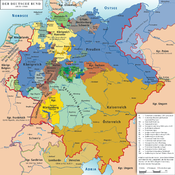- Saxe-Hildburghausen
-
Duchy of Saxe-Hildburghausen
Herzogtum Sachsen-HildburghausenState of the Holy Roman Empire,
State of the Confederation of the Rhine,
State of the German Confederation← 
1680–1826  →
→

Flag Coat of arms Capital Heldburg (to 1684)
Hildburghausen (from 1684)Government Principality Historical era Middle Ages - Partitioned from
Saxe-Gotha
1680 1680- Reichsunmittelbarkeit 1702 - Passed to Saxe-Meiningen 1826 Saxe-Hildburghausen (German: Sachsen-Hildburghausen) was an Ernestine duchy in what is now southern Thuringia, Germany. Its territory was similar to that of the modern Hildburghausen district.
History
Despite its tiny territory, this was an autonomous duchy from 1680 to 1826; in 1684 the capital was moved from Heldburg to Hildburghausen, and the mini-state became known as Saxe-Hildburghausen. The dukes built a palace, a French-style park and other pompous buildings in Hildburghausen.
In 1810, a princess of Saxe-Hildburghausen, Therese, was married to Crown Prince Ludwig of Bavaria, who became king of Bavaria 15 years later; this event is the reason for the Oktoberfest, held annually in Munich.
In 1826, the states of Thuringia were reorganised: the last ruler of Saxe-Altenburg died without an heir; the duke of Saxe-Hildburghausen became his successor, but he had to cede his own realm to Saxe-Meiningen.
In 1868, four districts were established in the Duchy of Saxe-Meiningen. Hildburghausen was one of these districts, with boundaries very similar to those of the former duchy. It remained almost unchanged until 1993, when the former district of Suhl was dissolved and most of its municipalities joined the district.
Dukes of Saxe-Hildburghausen
- Ernst II (1675–1715)
- Ernst Frederick I (1715–24)
- Ernst Frederick II (1724–45)
- Ernst Frederick III (1745–80)
- Frederick (1780–1825)
Incorporated into Saxe-Meiningen
Saxe-Weimar (1572–1806) · Saxe-Coburg-Eisenach (1572–1596, 1633-1638) · Saxe-Coburg (1596–1633, 1681–1699) · Saxe-Eisenach (1596–1638, 1640–1644, 1672–1806) · Saxe-Altenburg (1603–1672, 1826–1918) · Saxe-Gotha (1640–1680) · Saxe-Gotha-Altenburg (1681–1826) · Saxe-Marksuhl (1662–1672) · Saxe-Jena (1672–1690) · Saxe-Eisenberg (1680–1707) · Saxe-Hildburghausen (1680–1826) · Saxe-Römhild (1680–1710) · Saxe-Saalfeld (1680–1735) · Saxe-Meiningen (1681–1918) · Saxe-Coburg-Saalfeld (1735–1826) · Saxe-Weimar-Eisenach (1806–1918) · Saxe-Coburg and Gotha (1826–1918)

 Upper Saxon Circle (1512–1806) of the Holy Roman Empire
Upper Saxon Circle (1512–1806) of the Holy Roman EmpireElectorates 
Ecclesiastical Secular Anhalt (Bernburg · Köthen · Zerbst) · Barby · Hatzfeld-Gleichen · Pomerania (Further · Hither) · Querfurt · Reuss (Elder · Junior) · Saxe-Altenburg · Saxe-Coburg · Saxe-Eisenach · Saxe-Gotha · Saxe-Weimar · Schwarzburg (Rudolstadt · Sondershausen)Prelates Counts / Lords Hohnstein · Lohra / Klettenberg · Mansfeld · Schönburg (Saale) · Stolberg (Stolberg · Wernigerode · Rossla) States of the Confederation of the Rhine (1806–13)
States of the Confederation of the Rhine (1806–13)Rank elevated
by NapoleonKingdomsGrand DuchiesStates created KingdomsGrand DuchiesPrincipalitiesPre-existing
statesDuchiesAnhalt (Bernburg · Dessau · Köthen) · Arenberg · Mecklenburg (Schwerin · Strelitz) · Nassau · Oldenburg · Saxony (Coburg-Saalfeld · Gotha-Altenburg · Hildburghausen · Meiningen · Weimar3 · Eisenach3 · Weimar-Eisenach4)PrincipalitiesHohenzollern (Hechingen · Sigmaringen) · Isenburg-Birstein · Liechtenstein · Lippe-Detmold · Reuss (Ebersdorf · Greiz · Lobenstein · Schleiz) · Salm5 · Schaumburg-Lippe · Schwarzburg (Rudolstadt · Sondershausen) · Waldeck1 from 1810. 2 until 1810. 3 until 1809. 4 from 1809. 5 until 1811. States of the German Confederation (1815–66)
States of the German Confederation (1815–66)Empires 
Kingdoms Electorates Grand Duchies Duchies Anhalt (Bernburg2 · Dessau2 · Köthen3) · Brunswick · Holstein · Limburg4 · Nassau · Saxe-Lauenburg · Saxony (Altenburg5 · Coburg-Saalfeld6 · Coburg-Gotha5 · Gotha-Altenburg6 · Hildburghausen6 · Meiningen)Principalities Hesse-Homburg · Hohenzollern (Hechingen7 · Sigmaringen7) · Liechtenstein · Lippe · Reuss (Elder · Junior) · Schaumburg-Lippe · Schwarzburg (Rudolstadt · Sondershausen) · Waldeck and PyrmontCity-states Other territories
outside of the
confederacyColonial possessions · Personal unions of Habsburg (Bukovina · Croatia · Galicia and Lodomeria · Hungary · Lombardy–Venetia · Serbian Voivodeship and Banat8 · Slavonia9 · Transylvania) · Personal union of Hanover (Great Britain and Ireland10) · Personal unions of Hohenzollern (East Prussia11 · Neuchâtel12 · Posen, Gr. Duchy13 · Posen, Prov.14 · Prussia, Prov.15 · West Prussia11) · Occupied: Schleswig161 w/o areas listed under other territories. 2 Merged with Anhalt from 1863. 3 until 1847. 4 from 1839. 5 from 1826. 6 until 1826. 7 until 1850. 8 1849–60. 9 as of 1849. 10 until 1837. 11 until 1829. 12 until 1848/57. 13 until 1848. 14 as of 1848. 15 as of 1829. 16 as of 1864.Categories:- Former principalities
- Former countries in Europe
- States of the Holy Roman Empire
- States and territories established in 1680
- States and territories disestablished in 1826
- 1826 disestablishments
- States of the Confederation of the Rhine
- States of the German Confederation
- Ernestine duchies
- Dukes of Saxe-Hildburghausen
- House of Wettin
- History of Thuringia
- Upper Saxon Circle
Wikimedia Foundation. 2010.


